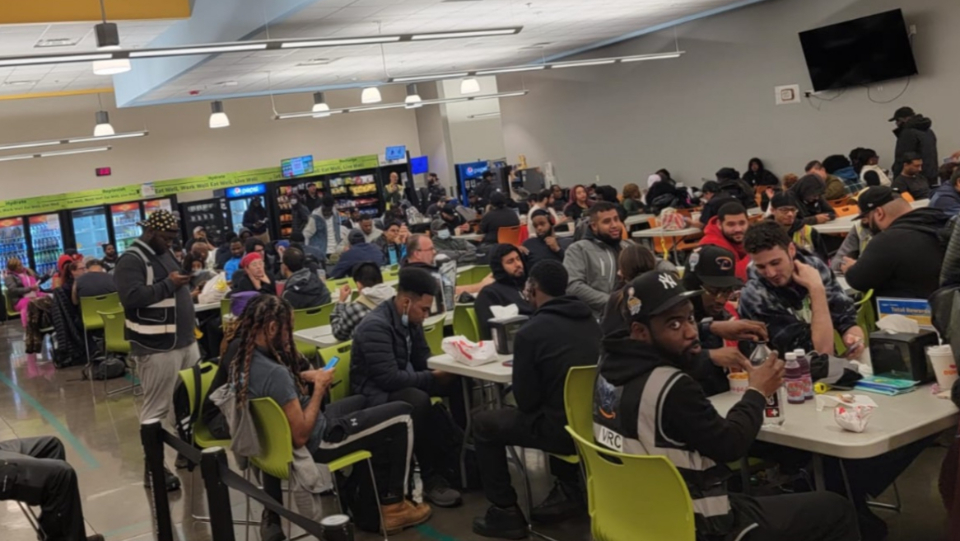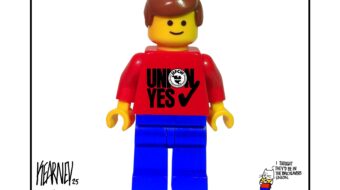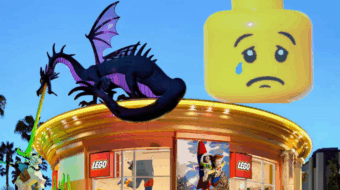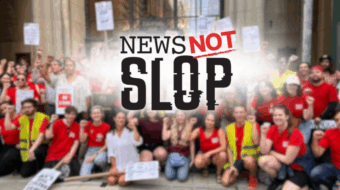
STATEN ISLAND, N.Y.—In the late afternoon of Oct. 3, a fire occurred at the sorting center at Amazon’s JFK8 warehouse here. The blaze started when a cardboard-box compactor at a loading dock ignited just before the scheduled shift changeover. With fumes and the smell of chemicals still hanging in the air after the fire was doused, Amazon ordered workers arriving for their evening shift to get to work—even after the employees expressed concerns for their health.
As a result, 650 workers entered the break room and another group went to the Human Resources department demanding they not be subject to unsafe working conditions. Amazon responded by suspending 80 workers in what labor leaders are calling a clear act of anti-union retaliation. The incident is the latest episode in a long history of the company refusing to uphold safety protocols, risking workers’ lives in order to secure maximum profit.
Around 4:00 pm, workers first reported the fire at the loading dock compactor. Employees could be seen on video screaming “Evacuate!” while running away from the blaze. At the same time, Amazon ordered workers to exit through the much slower turnstiles instead of the emergency fire exits, raising the danger that workers could be trapped inside the building. The company also refused the request by night shift workers starting their day to go home instead.
The evacuated employees were made to stand outside in cold, 50-degree rain in the parking lot for an hour while waiting for FDNY to arrive and battle the fire. Once the initial fire was extinguished, the day shift workers were allowed to leave an hour early with pay. But the company announced that all evening shift employees must report to work, saying the warehouse was deemed safe.

Later, Amazon management would claim that once the fire was doused, only a small group had refused to work. “Yesterday afternoon there was a small fire in a cardboard compactor outside of JFK8,” an Amazon spokesperson wrote.
“All employees were safely evacuated, and day shift employees were sent home with pay. The FDNY certified the building is safe and at that point we asked all night shift employees to report to their regularly scheduled shift. While the vast majority of employees reported to their workstations, a small group refused to return to work and remained in the building without permission.”
Workers on the ground, however, say that as many as 650 employees sat in the break room demanding they be sent home, stating that the working environment was dangerous for their health. After a few hours, Amazon demanded the workers go back to work and leave the breakroom, but many stayed behind to protest the unfair treatment.
At around 9:00 pm, about 100 of those employees did a “march on the boss,” going to the HR office and demanding night shift be sent home with pay. The fire itself may have been an avoidable event. Amazon Labor Union lawyer Seth Goldstein says the compactor had been causing problems and smoking for weeks.
What was Amazon’s solution to this clear hazard to workers’ safety? The multibillion-dollar company had been pouring water on the compactor to stop the smoke. They could have prevented this risk to employees’ health by evaluating the compactor, but this delay was apparently deemed impossible because it would cut into valuable profit.
How did the company respond?
After the work stoppage ended, 80 workers were suspended. The company placed them “under investigation” after they spoke up about safety hazards. These suspensions were done haphazardly, and seem to be targeted and malicious.
One worker reported that while all the women in her department who participated were suspended, none of the men were. The company has also tried to obfuscate the safety concerns and downplay the necessity for union activity. When the employees walked into the break room as an act of protest, management misstated the number of employees were involved in the walk out.
Chris Smalls, ALU president, said 650 refused to work in what they felt to be potentially dangerous conditions; the company claimed only 100 employees were involved—intentionally trying to downplay the scale of the action. The ALU said, “The ‘small group’ that refused to return to work made up 30% of the building by management’s own admission.”
Additionally, Amazon spokesperson Paul Flaningan publicly stated, “All employees were safely evacuated,” but this did not acknowledge the many workers who reported tearing up from exposure to smoke or the worker that had to be sent to the hospital from smoke inhalation.
Amazon’s report on the incident also did not account for the residual water, dust, debris, and potentially toxic chemicals being exhumed in the aftermath of the fire. All of this is in an attempt to not only camouflage to the public how often Amazon puts workers lives at risk, but also to erode support for the union.
Amazon workers lives have been at risk before
This is not the first time Amazon workers have had their lives put at risk for company profits. In 2021, as Tropical Depression Ida killed 14 people in the area surrounding JFK8, employees were still expected to go into work. Additionally, in the same year, a deadly tornado in Edwardsville, Ill., killed six Amazon workers because the company refused to close their warehouse in the middle of the storm.
In fact, in recent days, there have been three fires at different Amazon warehouses throughout the country.
Workers should not have to choose whether they will lose their job and maintain safety or keep their job and risk exposure to toxic chemicals, natural disasters, and death. But this is the sacrifice the company expects employees to make because without workers’ constantly exploited labor, Amazon’s entire basis for profit would be affected.
JFK8 is one of the most productive warehouses in the county, and the company would rather sacrifice the safety of employees than halt production and distribution at this key facility.

Recognize the ALU!
The ALU says it has a solution for keeping workers safe on the job: Amazon should recognize the ALU. The company has so far refused to recognize the decision of workers at JFK8, who in April voted to unionize. The company has clung to the position that the vote was fraudulent, a claim dismissed by the National Labor Relations Board.
Additionally, the company announced it would invest $1 billion dollars into higher wages, however, it has so far moved ahead on a mere $0.25 raise, and that after a year -long review process. The ALU points out that, with inflation rising to 9.1%, it is actually a cut in real wages by $1.85. This union says the situation proves once more the necessity of collective bargaining representation.
But the company is still trying to use its meager increase in wages as a tactic to devalue the union’s importance and convince workers that organizing is against their fundamental interests.
The company continues to refuse negotiations with the Amazon Labor Union. It is still campaigning to invalidate the election at JFK8, calling on the NLRB not to accept the outcome and accusing the government body of unfairly favoring the union because it denied all 25 objections Amazon made to the vote count.
For highly exploitative capitalist companies such as Amazon and Starbucks (which has seen 240 of its stores go union) a collective bargaining agreement threatens their total control over workers and their labor. But the ALU isn’t quitting, and the fire at JFK8 has pushed it to fight even harder to ensure workers’ lives are not put at risk and to make it clear that workers have the power when they are united.
As with all op-eds published by People’s World, this article reflects the opinions of its author.










